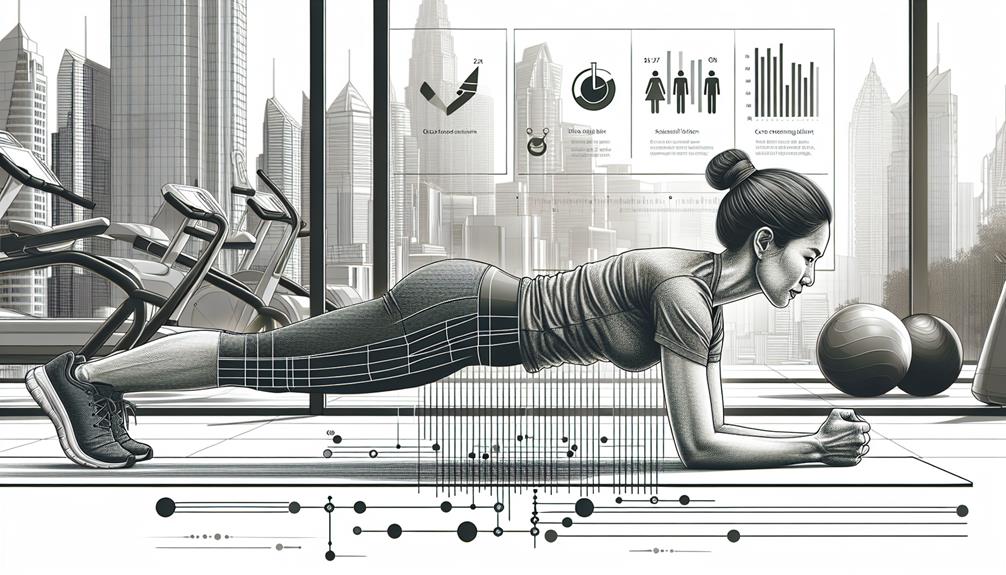You've heard the saying "a strong core is the foundation for success," and when it comes to your fitness journey, truer words have never been spoken. But how do you go about strengthening your midsection with precision? In this discussion, we will explore the core essentials that will help you achieve a stronger midsection and unlock your full potential. From understanding the importance of core strength to incorporating effective exercises, proper form and technique, stability and balance training, and even the role of nutrition, we will guide you on a comprehensive journey towards a stronger core. But before we unveil the secrets, let's take a moment to ponder the incredible impact a strong midsection can have on your overall fitness goals. Are you ready to take your fitness to the next level and discover the power of a strong core?
Key Takeaways
- Core strength is vital for overall physical fitness and injury prevention.
- Core exercises like Plank and Side Plank, as well as Pilates exercises, effectively target the midsection.
- Proper form and technique are essential for maximum results and to prevent strain or injury.
- Incorporating stability and balance training enhances midsection strength.
Understanding the Importance of Core Strength
Understanding the importance of core strength is vital for achieving overall physical fitness and preventing injuries. Your core is the central part of your body, consisting of muscles in your abdomen, back, and pelvis. Core stability is crucial for maintaining good posture, balance, and coordination. It also plays a significant role in supporting your spine and protecting it from potential injuries.
Core training focuses on strengthening and stabilizing the muscles in your core. By engaging in core exercises, you can improve your core stability, which helps enhance your overall athletic performance and reduce the risk of injuries. Core exercises target muscles such as the rectus abdominis, obliques, transverse abdominis, and erector spinae.
Some effective core exercises include planks, Russian twists, bicycle crunches, and bird dogs. These exercises engage multiple muscles in your core simultaneously, promoting strength and stability. It is important to note that core training should be incorporated into a well-rounded fitness routine that includes cardiovascular exercises, strength training, and flexibility exercises.
Effective Exercises for Targeting the Midsection
To effectively target your midsection, incorporating specific exercises that focus on strengthening and toning your core muscles is essential. Core focused yoga poses and Pilates exercises are both effective ways to engage and work your midsection.
Core focused yoga poses, such as Plank, Boat Pose, and Side Plank, require a strong engagement of the abdominal muscles to maintain stability and balance. These poses not only work the rectus abdominis (the six-pack muscles), but also the deeper core muscles, including the transverse abdominis and the obliques. Holding these poses for a few breaths at a time can help build strength and endurance in your midsection.
Pilates exercises are also known for their ability to target the midsection. Moves like the Hundred, Roll Up, and Criss-Cross engage the core muscles in a controlled and precise manner. Pilates focuses on deep abdominal engagement and proper alignment, making it an effective way to strengthen and tone your midsection.
Incorporating core focused yoga poses and Pilates exercises into your fitness routine can help you achieve a stronger and more toned midsection. Remember to perform these exercises with proper form and technique to maximize their effectiveness.
Proper Form and Technique for Maximum Results

To maximize the effectiveness of core-focused yoga poses and Pilates exercises for your midsection, it is important to maintain proper form and technique. Proper form ensures that you are targeting the right muscles and avoiding unnecessary strain or injury. One crucial aspect of proper form is proper breathing. Many people tend to hold their breath or breathe shallowly when performing core exercises, but this can limit the effectiveness of the movement and put unnecessary pressure on your body. Instead, focus on maintaining a steady and controlled breath throughout the exercise, inhaling deeply through your nose and exhaling fully through your mouth.
Another common mistake is relying solely on momentum rather than engaging the core muscles. It is essential to move with control and intention, using your core muscles to initiate and support the movement. Avoid swinging your body or using momentum to complete the exercise, as this takes away from the targeted work of the midsection.
Additionally, it is crucial to maintain proper alignment throughout the exercise. Pay attention to your posture and make sure your spine is neutral, avoiding excessive arching or rounding of the back. Engage your core muscles to stabilize your spine and maintain proper alignment. By focusing on proper form, breathing, and avoiding common mistakes, you can ensure that you are maximizing the results of your core exercises and strengthening your midsection effectively.
Incorporating Stability and Balance Training
Incorporate stability and balance training into your core-focused workout routine to enhance your midsection strength and overall body stability. These exercises not only target your abdominal muscles but also engage your deeper core muscles, improving your posture and reducing the risk of injury. Here are four stability and balance exercises that you can add to your routine:
- Plank: Get into a push-up position, resting on your forearms and toes. Keep your body in a straight line, engaging your core muscles. Hold this position for 30 seconds to a minute, gradually increasing the duration as you get stronger.
- Single-leg balance: Stand on one leg and lift the other leg off the ground. Maintain your balance for 30 seconds, then switch legs. This exercise challenges your stability and engages your core muscles.
- Side plank: Lie on your side, resting on one forearm and the side of your foot. Lift your hips off the ground, forming a straight line from head to toe. Hold for 30 seconds, then switch sides. This exercise targets your obliques and improves lateral stability.
- Bosu ball exercises: Perform exercises like squats, lunges, or planks on a Bosu ball. The unstable surface challenges your balance and engages your core muscles even more.
Incorporating stability and balance training into your core-focused workout routine will help you build a stronger midsection while improving overall body stability. Don't forget to start with proper form and gradually increase the difficulty as you progress.
The Role of Nutrition in Achieving a Stronger Core

Proper nutrition plays a crucial role in strengthening your core muscles and achieving a stronger midsection. By fueling your body with the right nutrients, you provide the necessary building blocks for muscle growth and repair. Additionally, maintaining a healthy diet can help you manage your weight, reducing excess fat that can hinder core strength.
One of the main benefits of nutrition for your core is its impact on muscle development. Proteins, found in sources like lean meats, eggs, and legumes, provide the amino acids needed for muscle repair and growth. Incorporating adequate protein into your diet supports the development of strong, lean core muscles.
Dietary guidelines also emphasize the importance of consuming a variety of fruits and vegetables. These nutrient-dense foods provide essential vitamins, minerals, and antioxidants that support overall health, including the health of your core muscles. Additionally, consuming whole grains, such as brown rice and quinoa, can provide sustained energy for your workouts, allowing you to perform core-strengthening exercises with greater intensity.
Furthermore, staying properly hydrated is essential for optimal core function. Water helps transport nutrients to your muscles and aids in the removal of waste products. Aim to drink at least eight glasses of water per day, or more if you engage in intense physical activity.
Frequently Asked Questions
Can Core Exercises Help to Reduce Back Pain?
Core exercises can help reduce back pain by strengthening the muscles in your midsection, which support your spine. A strong core improves overall spinal health and can help prevent back injuries.
How Often Should I Perform Core Exercises to See Results?
To see results from core exercises, you should perform them regularly. Incorporating effective core exercise routines for beginners into your daily workout routine can provide numerous benefits, including improved strength and stability.
Are There Any Specific Exercises That Can Help to Flatten the Stomach?
To flatten your stomach, try specific exercises that target your core muscles, such as planks, crunches, and Russian twists. Strengthening your midsection not only helps with a flat tummy but also improves daily activities and prevents injuries.
Can Core Exercises Improve Posture?
Can core exercises improve posture? Absolutely! Strengthening your midsection with precision not only enhances athletic performance but also helps improve digestion. Incorporating core exercises into your routine will lead to better posture and overall body alignment.
Is It Necessary to Use Equipment or Can Core Exercises Be Done Without Any Props?
You can strengthen your midsection with or without equipment. Using props like stability balls or resistance bands can add variety and intensity to your core exercises, but they're not necessary.
Conclusion
So, there you have it – strengthening your midsection with precision is essential for overall core strength. Effective exercises, proper form and technique, and incorporating stability and balance training are all key elements to achieving maximum results. But it's not just about the physical aspect – nutrition also plays a vital role in developing a stronger core. In fact, studies have shown that a diet high in protein can help increase muscle mass and improve core strength by up to 20%.













